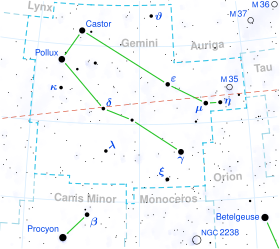| Observation data Epoch J2000 Equinox J2000 | |
|---|---|
| Constellation | Gemini |
| Right ascension | 07h 46m 07.45014s [1] |
| Declination | +18° 30′ 36.0217″ [1] |
| Apparent magnitude (V) | 4.89 [2] |
| Characteristics | |
| Spectral type | K4 III [3] |
| B−V color index | 1.425±0.034 [2] |
| Astrometry | |
| Radial velocity (Rv) | +83.13±0.08 [2] km/s |
| Proper motion (μ) | RA: −79.687 [1] mas/yr Dec.: −53.551 [1] mas/yr |
| Parallax (π) | 9.1500±0.2963 mas [1] |
| Distance | 360 ± 10 ly (109 ± 4 pc) |
| Absolute magnitude (MV) | −0.19 [2] |
| Orbit [4] | |
| Period (P) | 1,519.7±1.7 d |
| Semi-major axis (a) | ≥ 142±3 Gm |
| Eccentricity (e) | 0.325±0.015 |
| Periastron epoch (T) | 41,584±11 MJD |
| Argument of periastron (ω) (secondary) | 73±3° |
| Semi-amplitude (K1) (primary) | 7.21±0.13 km/s |
| Details | |
| 81 Gem A | |
| Mass | 1.22 [5] M☉ |
| Radius | 33.7+2.0 −1.7 [1] R☉ |
| Luminosity | 287.3±10.5 [1] L☉ |
| Surface gravity (log g) | 1.94 [6] cgs |
| Temperature | 4,095+109 −115 [1] K |
| Metallicity [Fe/H] | −0.18±0.06 [2] dex |
| Age | 6.32 [5] Gyr |
| Other designations | |
| g Gem, 81 Gem, BD+18°1733, FK5 1200, GC 10456, HD 62721, HIP 37908, HR 3003, SAO 97221, WDS J07461+1831AB [7] | |
| Database references | |
| SIMBAD | data |
81 Geminorum is a binary star [8] system in the northern constellation of Gemini. It has the Bayer designation g Geminorum, while 81 Geminorum is its Flamsteed designation. This system is visible to the naked eye as a faint, orange-hued point of light with an apparent visual magnitude of 4.89. [2] The pair are located approximately 360 light years away from the Sun, based on parallax, [1] and are moving further away with a radial velocity of +83 km/s, having come to within an estimated 164 light-years of the Earth nearly a million years ago. [2] 81 Geminorum lies close enough to the ecliptic to undergo lunar occultations. [4] [9]
The variable velocity of this system was first suspected at the Dominion Astrophysical Observatory in 1921, then confirmed by the Lick Observatory in 1922. It is a single-lined spectroscopic binary with an orbital period of 4.2 years and an eccentricity of 0.325. [4] The visible component is an aging giant star with a stellar classification of K4 III, [3] having exhausted the supply of hydrogen at its core then expanded to 34 [1] times the Sun's radius. It is over six [5] billion years old with 1.22 [5] times the mass of the Sun. This is a candidate alpha-enhanced star that displays a significant overabundance of silicon. [10] The star is radiating around 287 [1] times the Sun's luminosity from its bloated photosphere at an effective temperature of 4,095 K. [1]
